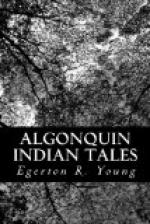CHAPTER XX.
Passing Hunters and Their Spoils—The Vain Woman—Why the Marten has a White Spot on His Breast.
As the home where Sagastao and Minnehaha lived was near a trail along which numbers of Indian hunters were accustomed to travel when on their way to the trading post with their furs, they frequently called in to see their loved friends the palefaces. These hunters were always welcome, and as they were very seldom in a hurry the children drew from them many a quaint Indian legend or story of animal life.
It was also a great pleasure for the children to have the hunters, returning from a successful trip, open their fur packs and spread out before them the rich furs and tell them stories about these animals—the silver fox, the otter, beavers, minks, martens, ermines, and sometimes even about great bears and wolves, whose skin they had often had. These valuable furs were generally well dressed and prepared for shipment by the industrious women before they were taken to the trading post. Sometimes, however, a hunter when on the trail to the trading post would find in one of his traps an animal just caught, and not having time to return to his wigwam and have the skin dressed and dried he would carry the animal just as it was and sell it to the fur traders.
One day there called a number of Indians, and among them was a hunter with a couple of martens which he had caught in his trap that very morning. Sagastao and Minnehaha had never seen these little animals before, and they handled them with much interest and asked several questions about them.
“Why has the marten that queer white spot on its throat?” asked Minnehaha.
The Indians looked at each other and a grim smile flitted over their bronzed faces when they heard this question.
Their conduct only the more excited the curiosity of the children and they both clamored for the answer. Then one of the Indians said:
“Ask Mary; she knows all about the story, and as a woman was in the affair she can tell it better than we can.”
With this answer the children had to be content, for the hunters, having drank their cups of tea, soon took their departure.
When the children found Mary they at once demanded the story.
“What story?” said Mary.
“O, you know what we want, for you were in the kitchen and heard what was said.”
[Illustration: Wigwams and Indians.]
But Mary still protested her ignorance, and declared that she had been so busy caring for Souwanaquenapeke that she had not listened to half the chatter that had passed between them and the Indians.
“O, I know you, sakehow Mary,” said Sagastao. “You don’t want to tell us because there was a woman like yourself mixed up in it.”
Mary bridled up with indignation, but before she could utter a word the arms of Sagastao were around her neck, and he cried:




